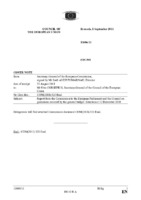| dc.description.abstract | The objective of this report is to monitor the credit risks borne by the budget of the European Union resulting from the guarantees given and the lending operations implemented directly by the European Union or indirectly through the EIB external mandates. This report is submitted pursuant to Article 130 of the Financial Regulation which requires the Commission to report to the European Parliament and to the Council twice a year on budgetary guarantees and the corresponding risks1. It is completed by a Commission Staff Working Document with a set of detailed tables and explanatory notes (the "SWD"). 2.TYPES OF OPERATIO S COVERED BY THE EU BUDGETThe risks covered by the budget of the European Union (the "Budget") derive from a variety of lending and guarantee operations which can be divided into two categories: –loans granted by the European Union with macroeconomic objectives, i.e. macro-financial assistance2 ("MFA") loans to third countries in conjunction with the Bretton Woods institutions, balance-of-payments3 ("BoP") loans granting support to non-euro Member States experiencing balance-of-payments difficulties, loans under the European financial stabilisation mechanism (EFSM)4 granting support to Member States experiencing difficulties beyond their control; and –loans with microeconomic objectives, i.e. Euratom loans and most importantly European Investment Bank ("EIB") financing of operations in non-Member States ("EIB external financing")5 that are covered by EU guarantees6. The guaranteed EIB external financing, the Euratom loans and the MFA loans have since 1994 been covered by the Guarantee Fund for external actions ("the Fund"),7 while BoP and EFSM loans are directly covered by the budget. The Fund covers defaults on loans and loan guarantees granted to non-Member States or for projects in non-Member States. It was established: EN 4 EN –to provide a 'liquidity cushion' in order to avoid calling on the Budget every time a default or late payment on a guaranteed loan arises; and –to create an instrument of budgetary discipline by laying down a financial framework for the development of EU policy on guarantees for Commission and EIB loans to non-member countries8. The Fund's coverage is withdrawn if third countries become Member States and the risk is transferred from the Fund to be directly borne by the Budget. The Fund is provisioned from the Budget and has to be maintained at a certain percentage of the outstanding amount of the loans and loan guarantees covered by the Fund. This percentage, known as the target rate, is currently 9%. If there are insufficient resources in the Fund, the Budget will have to provide the necessary Funds. |

